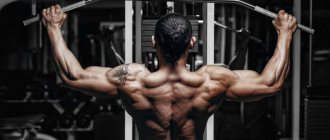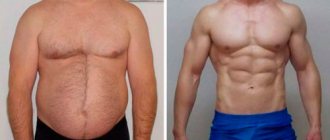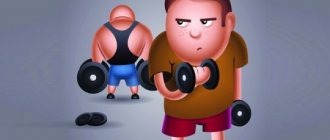If you are trying to improve the appearance of your body and transform your figure, then you need to achieve well-developed shoulders. Pumped shoulders combined with a wide back help visually narrow your waist. This is the type of figure most people strive for.
However, many of us are so busy that we don't always find time to exercise. In the hustle and bustle of everyday life, we often fail to get to the gym. What to do? Develop your shoulders without leaving home! We'll show you the best shoulder exercises and workouts you can do at home. No more excuses! Begin!
Shoulder muscles
The superficial muscle of the shoulder is called the deltoid. Anatomically, it is divided into three main bundles - anterior (anterior head), lateral (lateral head) and posterior (posterior head).
To develop shoulder muscles, two basic movements are enough: press and deadlift. The first movement is the press, and this includes exercises such as push-ups, handstand push-ups, dumbbell bench presses, or overhead presses.
A deadlift can be any movement where you lift any weight away from you. Examples include lifting dumbbells in front of you, doing dumbbell flyes, and even straightening your arms back with a dumbbell. The direction of movement will determine which shoulder muscles will work the most.
How to properly organize training taking into account the anatomical features of the shoulder?
It is impossible to talk about how to properly pump your shoulders without delving into the anatomy of the muscles.
The part that interests us in this article is the shoulder joint and the muscles surrounding it. First, let's look at the joint itself and its capabilities:
The shoulder joint is a hinge-type structure (the spherical head of the bone fits into the socket (glenoid fossa) of the scapula). Thanks to this design, the shoulder joint is the most mobile in the human body and has a wide range of motion (rotates in almost any direction).
The movement of the arm is carried out not only due to the joint, but also thanks to the deltoid muscle of the shoulder.
The muscle got its name due to the fact that it resembles the Greek letter delta (Δ) upside down. The deltoid muscle is divided into three heads: anterior, middle and posterior, which are responsible for different trajectories of arm movement.
Your home shoulder training should be based on understanding which deltoid head is working in a particular exercise, so let's look at this in more detail using illustrations.
Flexion of the shoulder from position A to position B occurs due to the FRONT delta beam. Extension of the arm from position A to position B is carried out due to the REAR delta beam. Thus, by moving the arm back and forth in a position parallel to the floor, we alternately engage the front and back bundles.
In the following image, the FRONT head of the shoulder moves the arm from position A to position B, and the BACK head moves the arm back.
In the next image, the movement of the hand from position B to position D is carried out due to ALL THREE bundles (but the back one is slightly involved).
Let's not forget about the incredible mobility of the shoulder joint, which allows it to move in all planes and also perform rotational movements. The FRONT head of the delta not only raises the arm up (flexes), but also supinates (turns inward). And the BACK part not only takes the arm back (extends), but also pronates (turns outward). Both movements can be seen in the image below:
Thus, if the FRONT and MIDDLE heads work simultaneously, then simultaneous flexion and slight abduction of the arm occurs. If the MIDDLE and POSTERIOR work, then extension and abduction.
Shoulder exercises at home clearly demonstrate this type of work:
In this case, the FRONT and MIDDLE heads work:
In this case, the REAR and MIDDLE heads work:
If you are hoping to pump up your shoulders at home without dumbbells and barbells, then there is only one type of training available to you - push-ups. If you look at the anatomy of this exercise, you can see that no matter how hard you manage to do push-ups, mainly only the FRONT delta bundle is involved. And this is unlikely to give your shoulder a uniformly rounded shape.
Shoulder exercises with body weight
There are a lot of bodyweight exercises that directly or indirectly target the shoulder muscles. Such exercises are very convenient, since they require a minimum amount of equipment and can be performed without leaving home.
Any push-up will work your shoulders, chest, and triceps. The angle at which the movement is performed determines the degree of load on a particular muscle. To work the shoulder muscles as intensely as possible, you need to push vertically.
Is it possible to build up shoulders without iron?
to pump up your shoulders without iron , but it requires a lot of effort . And by effort I no longer mean physical activity, but mental activity. Everyone can lift weights in the gym, not everyone does it correctly, many simply move weights back and forth, get injured, but one way or another, their muscles still grow.
But to pump up your shoulders at home with your own weight, you will have to do such circus performances and acrobatic acts that your relatives may think it’s time to call an exorcist.
It will be easier if you can use various available tools, such as water bottles, heavy objects, pets, and household appliances. But if your only arsenal is bodyweight exercises, then you've chosen the hard way.
Push ups
The effectiveness of push-ups is often underestimated. However, if done correctly, this exercise is great for developing shoulder muscles. It will also help work your arms, core and chest.
How to do it:
- Lie face down with your palms on the floor next to your shoulders. You can also place your palms on a bench (as in the video).
- Keep your back straight and push your hands off the floor/bench so that your torso rises up. Make sure your arms, wrists, and elbows remain in line throughout the entire movement.
- At the top, hold this position for a second and then lower to the starting position. Pause for a second and repeat the movement.
- Keep your core tight and taut throughout the movement.
- Try to complete 10 repetitions.
Incline push-ups
By elevating your feet on a bench, table, or chair, you can continue to work your shoulders, but with more ease. The higher your legs are, the better your shoulder muscles will work.
How to do it:
- Get into a push-up position and raise your feet onto a bench or chair.
- Place your palms on the floor slightly wider than shoulder-width apart. Keep your body and arms straight.
- Slowly lower yourself to the floor while keeping your legs elevated.
- Hold the position at the bottom for a second and push up again. Repeat.
- Start with three sets, performing as many reps as possible. Try to increase the number of repetitions each week.
Handstand push-ups
We know what you're thinking—there's no way you can do handstand pushups. The exercise may look overly difficult and seem almost impossible, but in reality, you don't need superhuman strength to perform it.
Handstand push-ups require a skill that can take some time to master. But you will never accomplish it if you don’t try. So give yourself a chance - try it!
How to do it:
- Stand against a wall and do a handstand.
- Straighten your legs and place your feet against the wall.
- Bend your elbows and lower your head towards the floor.
- Hold the position at the bottom of the movement for a second and rise up, straightening your arms.
- Stop for a second and repeat.
- Keep your core tense.
- Start with three sets, performing as many reps as possible. Try to increase the number of repetitions each week.
Avoid doing too many circuit exercises
If you are looking to build mass, we recommend that you avoid doing too many circuit exercises. It is better to perform one specific exercise at a time, taking into account the number of repetitions. To achieve the best results, increase muscle growth and strength, pay special attention to maximum contraction. If you find an exercise too easy, make it harder and increase the muscle-building potential.
Preparation for training
Before you start performing a set of shoulder training exercises, you need to do the best possible warm-up.
The shoulder is a very vulnerable place during the training process, which means that in case of poor warm-up (poor warm-up), the risk of injury increases greatly. Therefore, the warm-up is more important than the workout itself.
To avoid confusion and do everything correctly, the warm-up can be divided into three main parts:
- Preparatory part. In this part you need to perform simple movements, such as: stretching, circular movements, raising your arms up and raising your arms to the sides, general exercises.
- The main part of the warm-up. In the main part, you need to focus on warming up the body. To do this, you need to perform exercises that will maximize blood circulation and increase your heart rate. This can be arm swings, shoulder circles, rubbing the shoulder girdle (massage) and even jumping. The goal is one - to do everything to warm up.
- The final part of the preparation. Smooth transition from warm-up to training process. In this part, you need to perform simple basic exercises that do not require serious physical effort, and also prepare the shoulder part to increase the load on the muscles and joints.
Shoulder workout with dumbbells
Dumbbells are one of the best exercise equipment you can use to develop your shoulders. They are convenient to store at home because they do not take up much space. They are versatile and can be used to perform a huge number of exercises. Unlike bodyweight exercises, dumbbell exercises allow you to perform different types of movements. Bodyweight exercises often limit shoulder movement to a simple press, while dumbbells allow a wider range of motion, in all directions.
Sports equipment for shoulder training
To pump up your shoulders at home, you will need equipment. This is, of course, a barbell, weights and dumbbells. The role of a shoulder exercise machine could well be played by a Smith stand, which should be purchased for your home in any case. Support for the barbell is, in principle, optional; a partner can help lift the barbell without support; it is more important to have a strong and reliable bench for training. A bench is generally a universal sports tool, no matter what you do on it! Buy a bench with the ability to change the incline, you won’t regret it. Home training is a delicate matter, designed more for an amateur. However, without a minimum of equipment, home bodybuilding can turn into physical education.
Dumbbell Shoulder Press
This exercise primarily targets the shoulders, but also works the triceps and upper back muscles. This is one of the best exercises for developing your upper body as it involves many muscles working together. The more muscles involved, the more weight you can handle, and this is directly related to muscle growth.
How to do it:
- Choose a weight that is suitable for performing the required number of repetitions. Raise the dumbbells and lower them to shoulder level (or slightly higher). Palms facing forward.
- Raise the dumbbells above your head and clasp them together with your arms outstretched. Then lower the dumbbells to shoulder level.
- Perform movements in full amplitude - stretch your arms up and lower down. Repeat to complete the required number of reps and sets.
- To start, we recommend doing 3 sets of 8-12 reps.
How to pump up your shoulders at home and is it possible to do it quickly?
Unfortunately, you are unlikely to be able to build up big shoulders quickly at home. Even if you take into account that you will have a variety of equipment, you will still reach a certain “ceiling” that you can only overcome by training in the gym.
You can find out how to pump up your shoulder muscles yourself, but only a professional trainer, or “mentor,” can give you more practical information. In addition, working with a coach gives you another important advantage - outside assessment. You don't always notice your strengths and weaknesses. Only a coach can guide you in the right direction (especially for those who want to make really high-quality, outstanding form).
At home, you can do shoulder girdle exercises - master the exercises if you are a beginner, do stretching, learn to feel your muscles. This will be an excellent basis for moving on to more serious training in the gym.
Below we will tell you about the correct technique for exercises with dumbbells, which you can easily master at home.
Preparing for training and the difference between men's training and women's training
Well, now let’s move on directly to the practice of pumping shoulders with dumbbells at home.
Naturally, you will need equipment for training. The simplest and most affordable option is dumbbells. It is desirable that these be paired dumbbells in a certain weight range:
For women:
- 1.5 kg;
- 3 kg;
- 5 kg.
For men:
- 5 kg;
- 10 kg;
- 15 kg.
The best option for exercises with dumbbells on the shoulders for men is collapsible equipment. These dumbbells are designed like a barbell with interchangeable discs, so the weight can vary for your convenience.
Are there differences in shoulder workouts for women and men? In fact, no. In terms of technique and types, shoulder exercises for women and men will not be any different, but the set of these exercises can be completely different.
Thus, some women who naturally have a developed shoulder girdle prefer isolating exercises that develop the front and rear heads of the deltas, which makes the shoulders more rounded, but does not broaden them significantly. Some exercises that involve the maximum average head can help the deltoids grow wider. This option is ideal for girls with a wide waist who want to narrow it visually by expanding the shoulder girdle, buttocks and hips.
Also, regarding preparation for home workouts for beginners, remember the basic rules:
- Don’t chase the scales, but try to practice your technique;
- In exercises, work slowly and at full amplitude - this will allow you to feel the target muscles and improve the neuromuscular connection;
- Be sure to include basic exercises in your program - this will allow you to develop strength and increase weights in the future, which means you will progress in shape.
Do not forget that before each workout, a warm-up is carried out, which will allow blood to flow to the target muscle group and warm up the joints and ligaments.
Raising dumbbells in front of you
This exercise primarily strengthens the deltoids, but also works the upper chest (pectoral) muscles. It should be performed if this part of your shoulder is not sufficiently developed. When performing a bench press, the front deltoid will be worked hard, so be careful not to overtrain this part of the body.
How to do it:
- Stand straight, arms down, dumbbells resting on the sides of your thighs, palms facing inward.
- Raise your arms one at a time in front of you so that the dumbbell is parallel to the floor, just above the shoulder line. Your arm should be almost straight with your palms facing the floor. The elbow should not strain. The other arm is extended down.
- Pause for a second at the top of the movement and slowly lower the dumbbell down. Then repeat the movement with the other hand.
- Aim for 2 to 3 sets of 10 to 15 reps with each arm.
Anatomy of the muscles of the shoulder girdle
Your shoulders are made up of three main muscles known as the deltoids or deltoids. They are a group of triangular muscles.
- Anterior Deltoids (Anterior)
- Medial Deltoids (Middle)
- Rear Deltoids (Back)
In this article, we'll focus on deltoid exercises because these are the superficial muscles (muscles that can be seen when they're close to the surface of the skin) and are what most people think about when they do a shoulder workout. And they want broad shoulders.
The deltoids are the prime movers, so they will give you the strength and power we want for pushing movements. Moreover, the deltoids are what create the toned, broad shoulders that pop outwardly.
ANTERIOR DELTOID MUSCLES
The anterior deltoid muscles are located on the front surface of the forearm. They attach to your collarbone, allowing you to flex and internally rotate your shoulder joint. Your front deltoids are primarily used when you lift or press your arms in front of you (such as front raises and push-ups).
MEDIAL DELTOID MUSCLES
The medial deltoids are located on the side of the shoulder. They attach to your shoulder blade and are primarily used with exercises that bring your arms to your sides or overhead (such as overhead push-ups and lateral raises).
REAR DELTOID MUSCLES
The posterior deltoids are located on the back of the forearm. They are also attached to your shoulder blade, allowing you to extend and rotate your arm laterally. They also prevent you from leaning forward. The rear deltoids are primarily used in exercises that bring the arms behind the back.
Note: The rear deltoids are the stabilizers of the anterior and middle deltoids under pressure. For example, when you do an upper press, your rear deltoid acts as a stabilizer. The rear delts will be the prime movers during the pulling movements.
ARE THE TRAPEZIS PART OF YOUR SHOULDERS?
The trapezius is a broad, flat, superficial muscle that resembles a trapezius. They extend from the cervical region to the thoracic region on the back of the neck and torso. Although they are not part of your shoulder, they often work during shoulder movements. Back exercises only work the middle trapezius. This is why people often train their shoulders and traps on the same day.
Dumbbell lateral raises
Dumbbell lateral raises work the lateral head of the deltoid. This muscle is located on the outside of the shoulder and, when fully developed, gives the shoulders a three-dimensional appearance and makes your figure appear wider. The exercise works the shoulder using dumbbell rows.
How to do it:
- Stand up straight and hold dumbbells in each hand. The arms are lowered down to the sides, palms facing inward.
- Slowly raise the dumbbells to the side until your arms are parallel to the floor. Hold this position for a second and slowly lower your arms to the starting position.
- Keep your core tight and don't swing your hips to avoid shifting your weight.
- Aim for 2 to 3 sets of 12 to 15 reps.
How to build broad shoulders with dumbbells?
- Raising your arms to the sides. Hold dumbbells in both hands. Choose weight individually, taking into account personal physical fitness. At the same time, spread the dumbbells to the sides and slowly lower them down. Perform the exercise 4 sets of 5-8 times. As your physical condition improves, you can remain in a static position for some time, with your arms outstretched at an angle of 90 degrees.
- Starting position: sitting on a stool or bed. Dumbbells in hands. Simultaneously lift the dumbbells up and then lower them to shoulder level. It is important that the movements are as smooth as possible without jerking. Do at least three approaches 5-10 times.
- Variable lifting of dumbbells in the starting position while sitting. Do the same as in the previous exercise, but alternately. First, lift the dumbbell in your right hand, then, when it comes down, lift the dumbbell in your left hand. Continue doing the exercise until fatigue sets in or mild muscle pain appears. It is important not to bring yourself to a state where it is impossible to endure pain and stop in time. On average, this will be 4 sets of 15 times on each arm. You need to determine the weight yourself, but on average it is 5-10 kilograms, perhaps less.
Bent-over dumbbell raises
This exercise works the posterior deltoid muscle. Developed rear deltas give the shoulders a fully developed, rounded appearance. Of all the shoulder muscles, this is usually the most difficult muscle to tone. It is worked out during a pulling movement with weights, but when the body is not straightened, but tilted forward.
How to do it:
- Stand up and bend your torso forward towards the floor. Keep your lower back straight so that your torso is almost parallel to the floor. Keep your head in a neutral position and do not pull your neck upward.
- Take dumbbells in your hands. Hands are lowered in front of you, palms facing each other. Make sure your elbows are relaxed and slightly bent.
- Engage your rear delts and pull your elbows up, spreading your arms out to the sides. The dumbbells should be at the top, almost parallel to the floor, with your palms facing down.
- Avoid body rocking. Keep your core tight throughout the movement.
- Aim for 2 to 3 sets of 12 to 15 reps.
Conclusion
To properly work out your shoulders, you don’t need to have some fancy equipment on hand or go to the gym. If you incorporate these exercises into your regular workout routine, you will see noticeable improvements within a few weeks.
Just remember to use proper form and go through a full range of motion to ensure your shoulder muscles are working and developing correctly. Once you have mastered these exercises, begin to make them more difficult by gradually increasing the number of repetitions.
Articles on our website are presented for educational and informational purposes only. We do not recommend using article materials as medical advice. If you decide to take dietary supplements or make fundamental changes to your diet, first consult with a specialist.
Translation: Farida Seidova
Are you training at home? Then you will also be interested in this article:
Workout
How to pump up your shoulders with dumbbells at home - the best exercises
Well, now let’s move on directly to what exercises to pump up your shoulders at home?
First of all, these will be exercises with dumbbells, and, in general, a beginner should not bother with anything more. Dumbbells will allow you to work out all the deltoids and are a truly effective and efficient option for pumping up your shoulders.
Don’t forget that the best exercises for a guy that will help you build up your shoulders quickly are the basic ones! Focus on them to develop strength and be able to increase working weights.
Below we will describe all the exercises in more detail; you will learn how to pump up your shoulders with roundness, as well as how to make them visually wider. Be sure to pay attention to the anatomy of the technique in order to understand how a certain type of load affects the heads of the deltas.
So, the best shoulder exercises with dumbbells:
- Press standing or sitting;
- Arnold Press;
- Lifting or spreading through the sides;
- Lift or swing in front of you;
- Lifting or bent over swings;
- Lifting or pulling to the chin;
Dumbbell press standing or sitting
Type of exercise: multi-joint.
Load area: the shoulders swing due to the contraction of all beams (heavy load on the middle and front head).
Features of the technique: depending on the angle of rotation of the forearm, the load can shift from the front deltoid to the middle one, and vice versa. So, if you sit straight and your forearm is parallel to your body, then the emphasis is transferred to the middle delta (you can strengthen this emphasis by turning your palm as far as possible towards the ceiling). If you sit tilted back, your forearm moves about 15 degrees from parallel to the body, and the emphasis is transferred to the front deltoid. You can also place emphasis on the front deltoid by placing your arms and shoulders in front of your body and pressing movements in front of you.
Arnold press
Type of exercise: basic.
Load area: the entire delta is involved (when you rotate the forearm, the back head is activated).
Features of the technique: pumping your shoulders with dumbbells in the Arnold press is quite difficult. The main feature of this exercise is that you can engage the rear deltoid while rotating your forearm. A mandatory nuance is to move the arm from a position in front of you to a position on the side of the body, simultaneously with the rotation of the forearm.
It will be quite difficult for a beginner to “feel” the work of the deltas in this exercise for the arms and shoulders, especially with regard to the back head. So it is recommended for beginners to start with a regular bench press.
Dumbbell raises or lateral raises
Type of exercise: isolation.
Load area: the entire delta is involved, but the emphasis is on the middle one.
Features of the technique: in this shoulder exercise, it is advisable to keep your arms with dumbbells straight in order to maximally engage the middle delta. But, an option is allowed when the arms are bent at the elbows, which additionally turns on the front delta (if desired, you can turn on the front delta by turning your arm inward when lifting). To work the middle beam in isolation, you need to keep your palms strictly parallel to the floor. Lifting the projectiles is carried out strictly with the shoulders, without swaying the body.
Lifting dumbbells or swinging in front of you
Type of exercise: isolation.
Load area: the middle and anterior deltas are involved, with an emphasis on the latter.
Features of the technique: according to the classical scheme, the exercise is performed with straight arms, palms facing the floor. But for maximum isolation of the front beam, your hands can be turned palms up. To make this technique more convenient, you can pick up one dumbbell in your hands, lifting it as if you were scooping up water.
Swings are great for isolating individual bundles, but if you answer the question whether you can pump up your shoulders only with swings, the answer will be ambiguous. Why?
Remember when we said that basic exercises are essential to developing shoulder strength? So, by performing only swings and giving an isolating load, you will lift working weights very slowly, accordingly, getting less return from training and less muscle growth.
Dumbbell raises or bent over swings
Type of exercise: isolation.
Load area: the middle and posterior muscles of the shoulder are involved, with an emphasis on the latter.
Features of the technique: according to the classical scheme, tilted swings are performed from a position of the torso “parallel to the floor” with straight arms. To make it easier, you can bend your elbows slightly. Make sure you grip and tilt your torso so that your shoulder maintains a position “perpendicular to your torso” even during movement. If you are doing the exercise for the first time, it may be difficult for you to swing with both arms at the same time. So it is possible to perform the exercise with one hand.
If you want to build broad shoulders, then be sure to combine bent over swings with dumbbell raises to the sides.
Lifting dumbbells or pulling to the chin
Type of exercise: multi-joint.
Load area: the middle and front deltas are involved, with an emphasis on the middle, depending on the position of the hands.
Features of the technique: pulling with dumbbells at home is performed according to the same scheme as with a barbell. The advantage is that you can spread your arms out to the sides as much as possible so that your shoulder moves in the plane of your torso. If you move your shoulder out of the plane of your body and make movements in front of you, you engage the front delta as much as possible.
Pulling allows you to make your shoulders more rounded, but requires the correct technique, as it also works well on the trapezius. If the technique is violated, it can pull most of the load onto itself.
Shoulder training program at home
What's the best way to lift your shoulders at home? If you're a beginner, incorporate shoulder exercises at home into your training split along with muscle groups such as your back and/or legs. If you've been training for a long time, you can devote an entire workout to deltoids.
As for the training program, it will look something like this:
First day:
- Dumbbell press standing or sitting;
- Dumbbell raises to the sides;
- Dumbbell rows to the chin;
- Swing dumbbells in front of you.
Second day:
- Arnold Press;
- Bent-over dumbbell swings (rear deltoid);
- Dumbbell press standing or sitting;
- Dumbbell raises to the sides.
We perform 3-4 working approaches in the range of 8-15 repetitions.
Answering the question of how to build broad shoulders at home, let’s say that to do this you just need to do as many basic exercises as possible! For beginners, it is advisable to start with a classic standing or sitting press, since the Arnold press will be quite difficult for them in terms of execution technique.











